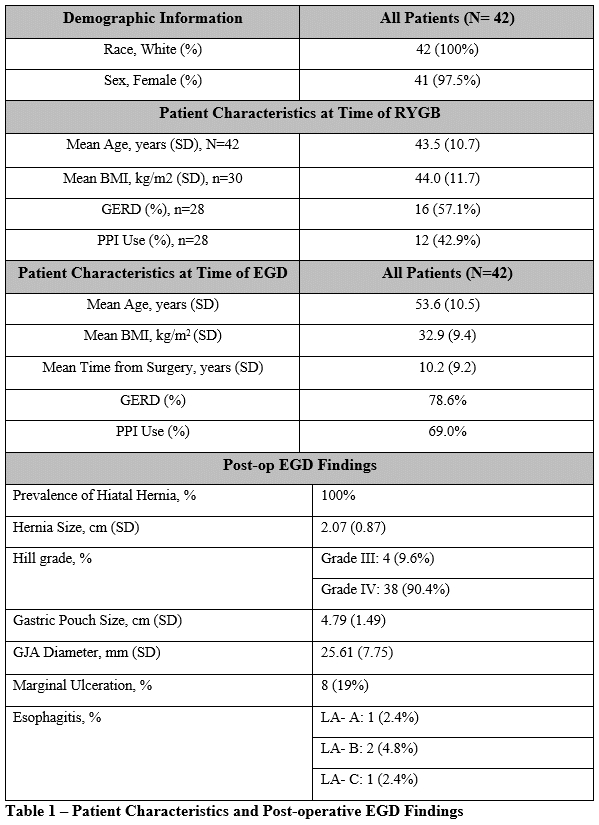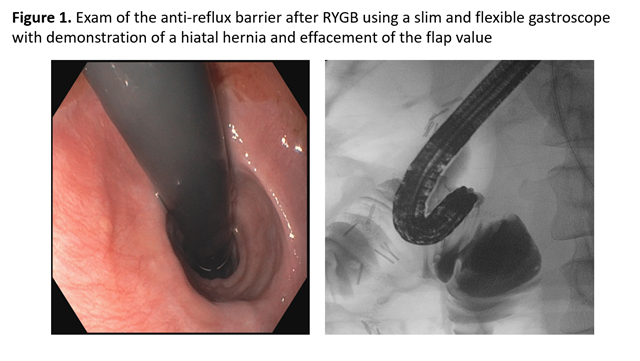Back to 2024 Abstracts
MECHANISMS OF GASTROESOPHAGEAL REFLUX POST-ROUX-EN-Y GASTRIC BYPASS: UNIVERSAL ALTERATION OF THE ANTI-REFLUX BARRIER IS THE CULPRIT
Karim Al Annan
*, Razan Nabeel Mousa Aburumman, Rudy Mrad, Khushboo Gala, Barham K. Abu Dayyeh
Gastroenterology and Hepatology, Mayo Clinic Minnesota, Rochester, MN
Background: Roux-en-Y Gastric Bypass (RYGB) is often preferred for patients with obesity and gastroesophageal reflux disease (GERD), as it typically reduces reflux symptoms. However, post-RYGB, GERD symptoms and the use of proton pump inhibitors (PPIs) remain prevalent. The challenges in assessing the esophagogastric junction (EGJ) and diaphragmatic hiatus through fluoroscopic and cross-sectional imaging have prompted us to conduct a consecutive endoscopic evaluation. This study aims to investigate alterations in the anti-reflux barrier (ARB) in this cohort. Specifically, we seek to determine the prevalence of hiatal hernia (HH) and flap valve disruption in patients post-RYGB, utilizing flexible retroflexed endoscopy.
Methods: In this consecutive cohort study, we examined patients who underwent Roux-en-Y Gastric Bypass (RYGB) and subsequenty had an upper endoscopy, conducted by an expert bariatric endoscopist. The primary focus was on pouch endoscopic retroflexion to evaluate the anti-reflux barrier (ARB). For comprehensive analysis, both video and image documentation were uploaded to a secure registry (see
Figure 1). We gathered data encompassing patient demographics, anthropometrics, comorbidities, and findings from esophagogastroduodenoscopy (EGD) at the time of surgery and during follow-up EGD. Continuous variables were presented as mean ± standard deviation (SD), and categorical variables as frequencies (%).
Results: Our study included a total of 42 patients, predominantly female (97.5%) and white (100%), with an average age of 53.6 ± 10.6 years and a body mass index (BMI) of 32.9 ± 9.4 kg/m
2. In our findings, all post-operative EGDs revealed the presence of a hiatal hernia (HH) of varying sizes. The average HH size was 2.07 ± 0.87 cm. The EGJ flap was also effaced in all patients with the majority (90.4%, 38 patients) classified as Hill grade IV and a smaller proportion (9.6%, 4 patients) as Hill grade III, as detailed in
Table 1. Notably, proton pump inhibitor (PPI) usage increased from the time of surgery to the time of EGD (69.0% vs. 42.9%, p = 0.06).
Conclusion: This research highlights the high incidence of hiatal hernia (HH) and esophagogastric junction (EGJ) flap effacement in patients after Roux-en-Y Gastric Bypass (RYGB), potentially elucidating the persistence of reflux symptoms, including weakly acidic or alkaline reflux, post-RYGB.

Table 1 - Patient characteristics and post-operative EGD findings

Figure 1 - Exam of the anti-reflux barrier after RYGB using a slim and flexible gastroscope with demonstration of a hiatal hernia and effacement of the flap valve
Back to 2024 Abstracts

